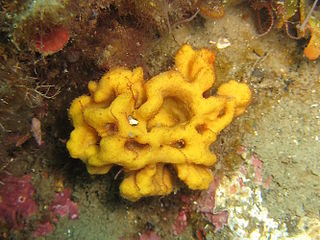
Tanita Tikaram is a British pop/folk singer-songwriter. She achieved chart success with the singles "Twist in My Sobriety" and "Good Tradition" from her 1988 debut album, Ancient Heart.
Geodia gibberosa, comonly known as the white encrusting sponge, is a species of sea sponge found in the Caribbean. It is eaten by hawksbill turtles. It was first described by Lamarck in 1815.

Geodia is a genus of sea sponge belonging to the family Geodiidae. It is the type genus of its taxonomic family.

Axinella is a genus of sponges in the family Axinellidae. Species of Axinella occur in the Indian and Pacific Oceans. Most of these sponges are smaller than 20 cm, and have a yellow or orange colour.
Stelletta is a genus of sea sponges belonging to the family Ancorinidae.

Haliclona is a genus of demosponges in the family Chalinidae.

Chondrilla is a sea sponge genus belonging to the phylum Porifera.
Homaxinella is a genus of sea sponges, demosponges in the family Suberitidae. The type species is Homaxinella balfourensis.
Myxilla is a genus of demosponge belonging to the family Myxillidae. These sponges usually form encrustations on rock surfaces.

Callyspongia is a genus of demosponges in the family Callyspongiidae.
Geodia exigua is a species of sponge that produces the sesquiterpene spiro compound exiguamide. The species was first described by Johannes Thiele in 1898. It is a marine organism known from Japan.
Geodia composita is a species of sponge in the family Geodiidae. The species was first described by Bösraug in 1913. It is found off the coasts of Mozambique.
Geodia strongyla is a sponge species from the Geodiidae family. The species is found off the coasts of Japan and was first described by Kazuo Hoshino in 1981.

Craniella is a genus of marine sponges in the family Tetillidae.
Caminus is a genus of sea sponges belonging to the family Geodiidae.
Geodia agassizi is a species of sponge in the family Geodiidae. The species is found in the eastern tropical Pacific Ocean and was first described by Robert Lendenfeld in 1910.
Geodia alba is a species of sponge in the family Geodiidae. The species is found in the waters of Indonesia and was first described by Oswald Kieschnick in 1896 as Synops alba.
Esperiopsis is a genus of demosponges, comprising around 30 species found in oceans around the world.
Geodia hirsuta is a species of sponge in the family Geodiidae. The species is found in the waters of Indonesia and was first described by Sollas in 1886 as Cydonium hirsutum.
Geodia anceps is a species of sponge in the family Geodiidae. The species is found in the western part of the Mediterranean Sea and was first described by Gualtherus Carel Jacob Vosmaer in 1894 as Synops anceps.







